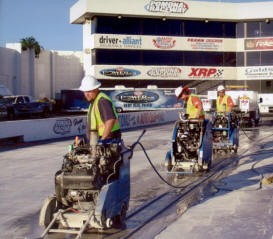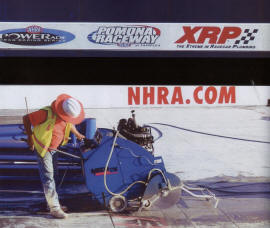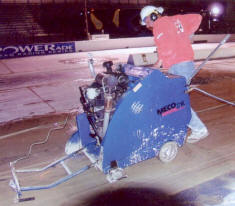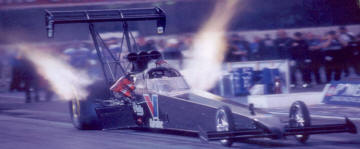|
|
|
March 2005 Concrete Openings article & cover picture
Flat Sawing to the Finish Line
CSDA Contractor Gets Green Light on Drag Strip Removal Job
| |
 On the Pomona Raceway in late December 2004, the parallels between drag racing and concrete cutting were as clear as the California sky. The need for speed, safety, power and precision were paramount — just like on race day — as CSDA member United Concrete Coring & Sawing, Inc. prepared to flat saw 200 feet of the drag strip for removal and replacement. On the Pomona Raceway in late December 2004, the parallels between drag racing and concrete cutting were as clear as the California sky. The need for speed, safety, power and precision were paramount — just like on race day — as CSDA member United Concrete Coring & Sawing, Inc. prepared to flat saw 200 feet of the drag strip for removal and replacement.
The historic Pomona Raceway, part of the Los Angeles County Fairplex facility, is the oldest venue on the National Hot Rod Association (NHRA) drag racing circuit. The NHRA, the world’s largest motor sports association, held its first official race in April 1953 on a slice of the LA County Fairgrounds parking lot — now the Pomona Raceway. Prior to the construction of this track, hot rod enthusiasts had congregated in the dry lake beds of the Mojave Desert, where in the early 1930s they topped 100 MPH for the first time.
Four decades after the NHRA’s first race, the Pomona Raceway underwent renovation as part of a $6 million expansion project. The aggressive renovations included upgrading the entire facility to stadium quality with fan amenities such as VIP towers and tall grandstands. Now, the popular raceway hosts several NHRA events including the season-opening internationals, Sport Compact World Finals and Summit Racing Series National Championship. The complex boasts 40,000 permanent grandstand seats and a 14,600-square-foot tower complete with corporate suites and a modern press center. The track's entire 1,320-foot racing surface was repaved in 2001 to extend the concrete launchpad from 330 to 660 feet.
|
| |

In late 2004, the Pomona Fairplex Facilities Department made the decision to remove and replace a large section of the drag strip because years of heavy use had caused deterioration, especially in the burn out area where the cars took off. The Department contracted United Concrete Coring & Sawing, Inc. of Riverside, California, to remove the first 200 feet of the two drag strip lanes. Each lane was 20 feet wide and consisted of 10-inch-thick concrete reinforced with rebar. It also included a Class 2 sub-base with 90 percent compaction (standard for material placed under all concrete roadways during construction) and conduits that held the starting line wiring for lights and tree sensors. Concrete cutting operators could not disturb the sub-base or any of the conduits.
Concrete cutting was the best method to meet the demands of this job for a number of reasons. It was the fastest, most cost-effective method and also allowed for the removal of the drag strip without disruption to the sub-base. It also provided very clean cuts, an important consideration because the removed concrete would be used to construct a walkway through a garden area next to the NHRA Motorsports Museum on the Fairplex grounds. Hy-ram and Bobcat removal were considered but quickly dismissed because of the noise factor and time restrictions. Also, these other methods would not have allowed for the drag strip pieces to be reused as walkways.
The project needed to be completed in one working day due to the Facilities Department closing for the Christmas Eve holiday. Operators were also pressured by the threat of heavy rain forecasted to hit Southern California the week after Christmas, so work had to proceed quickly with no delays. Adequate time was needed for the new slab to be poured and cured before the opening day of race season in February 2005.
|
| |
 In order to start this job, United operators completed a detailed layout by snapping chalk lines and spraying clear acrylic over the lines. Because the cut pieces would be reused as walkways, operators had to ensure layout marks would not be visible later. Spray paint would have interfered with the "stepping stone" effect that would later be applied to the concrete before being replaced. In order to start this job, United operators completed a detailed layout by snapping chalk lines and spraying clear acrylic over the lines. Because the cut pieces would be reused as walkways, operators had to ensure layout marks would not be visible later. Spray paint would have interfered with the "stepping stone" effect that would later be applied to the concrete before being replaced.
With layout complete, operators were ready to start their engines. From the starting line, they began flat sawing the two lanes of the drag strip into 3-foot by 3-foot squares. United Concrete decided that in order to complete the cutting in the one-day time frame, cutting in a gradual step-cut order was the best choice. Step cutting with three saws was the best way to cut a checker board layout to ensure each cut reached complete depth in one pass. Operators followed each other in line, the first one cutting with a 14-inch blade, the second with an 18-inch blade and finally the third with a 24-inch blade. The first operator cut to a depth of about 2 inches to keep the cut straight, the second cut to 7-1/2 inches and the third completed the cut to the required 10-inch depth. The blade segment sizes were 24 x 0.165, 18 x 0.165 and 14 x 0.165.
To protect all electric wiring in the sub-base, two 2-foot by 20-foot sections of the drag strip were only cut to a depth of 3 inches, instead of the full 10 inches. This area containing the wiring required special attention from the Facilities Department.
Operators followed all the appropriate safety precautions including wearing Personal Protective Equipment (PPE), hard hats, ear protection and safety glasses.
Equipment used on the job included three combo trucks, one 35-HP Meco flat saw spinning the 14-inch blade, one 42-HP Meco flat saw spinning the 18-inch blade and one 65-HP Meco flat saw spinning the 24-inch blade. All blades were Terra Diamond cured concrete blades.
|
| |

As planned, the cutting was completed in one day with total job time from layout to completion amounting to 15 hours. Two of these hours were devoted to layout as it was extremely important to ensure the uniform size of concrete squares to be reused in the museum walkway. In all, United operators cut a total of 3,885 feet of 10-inch-thick, rebar-reinforced concrete.
United Concrete has completed a variety of jobs for the Pomona Fairplex Facilities Department including demolition work, wall sawing, core drilling and slab sawing. Many of the jobs take place just prior to the annual Los Angeles County Fair, one of the largest sources of income for the Fairplex. United Concrete is often called out to provide services on a same-day basis, earning the company a reputation for responsiveness any day of the week and any time of day. This has led to a solid working relationship between United Concrete and the Pomona Fairplex.
Tom McCloud, co-owner of United Concrete Coring & Sawing, was satisfied that his company was able to meet the time and budget needs of the Pomona Fairplex Facilities Department. "We were very satisfied that our crew wrapped up the job in one day from start to finish," McCloud said. "It was a clean job with very straight cuts so the slabs could be reused."
|
| |
COMPANY PROFILE
United Concrete Coring & Sawing, Inc. was started in 1993 by two brothers, Randy and Tom McCloud. The company has eight trucks and one branch location. They offer a complete line of equipment to serve all their customers’ concrete cutting needs. Most importantly, they have a crew of employees that gives 110 percent every day, on every job. United Concrete has been a member of CSDA since 1996.
RESOURCES
General Contractor: Pomona Fairplex Facilities Department
Sawing & Drilling Contractor: United Concrete Coring & Sawing, Inc. Riverside, CA
Methods Used: Flat Sawing
Tel: 951-789-1934
Fax: 951-789-1910
Web: www.unitedconcreteinc.com
e-mail: united@spamcurb.com
|
|
|
|
|
|

